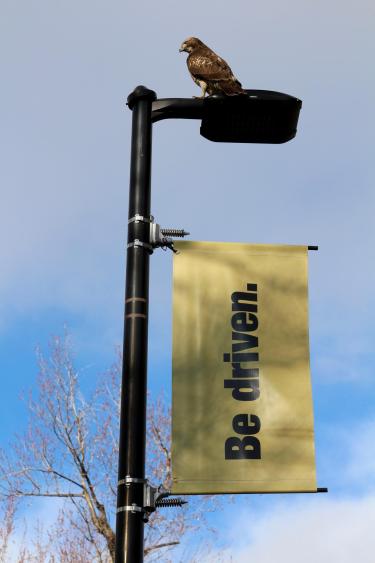Tips for co-existing with campus wildlife

Hawk on campus. Photo by Craig Levinsky.
CU Boulder’s campuses are home to, or frequented by, raccoons, deer, squirrels, beavers, prairie dogs and dozens of species of birds. Foxes have also been making a rebound in the area. On rare occasions, we even get visits from larger animals such as coyotes and bears.
It’s important to remember, however, that wildlife is wild for a reason and should be treated as such for the well-being of both the animals and our people. CU Boulder’s Environmental Services team offers a few simple reminders for students, faculty and staff about interactions between people and wildlife.
- Do not approach or feed wild animals on campus, even squirrels or birds.
- Do not feed the turtles or fish living in and around Varsity Lake, the Kittredge ponds or other ponds around campus.
- If you come across an injured or dead animal, report it to the CU Facilities Management (FM) service desk at 303-492-5522 so that designated campus employees can properly assist or remove the animal.
- Problems or human contact with squirrels, rodents, birds or other animals can likewise be reported to the FM service desk at 303-492-5522 at any time of day or night.
- Colorado Parks and Wildlife’s (CPW) website includes several resources and tips, including how to avoid wildlife conflicts and why feeding wildlife is a bad idea. Websites for the city of Boulder and Boulder County also include valuable information related to local wildlife.
- Remember, we are in pre-hibernation season, with bears needing to consume 20,000 calories; you could very likely see a bear during this time period. We want to get them off campus safely and do not want to tag a bear unless absolutely necessary—a tag will show CPW that it has been to the city once, and two tags on a bear’s ears mean it will need to be euthanized by state law.
“CU Boulder’s setting provides ample opportunities for observing wildlife, enhancing our enjoyment of campus and the outdoors,” said Troy Muller, wildlife manager and integrated pest manager at CU Boulder.
CU staff work together with wildlife specialists, Boulder Animal Control and Colorado Parks and Wildlife when dealing with wildlife issues on campus. Muller said the animals are handled with the utmost care to ensure their safety. They are usually sent to an animal refuge or up in the mountains to distance them from civilization.
“CU also invests in having an Integrated Pest Management department to make sure that when animals find their way to campus, they are cared for properly and, when necessary, safely removed from campus, ensuring the campus populace and the animal are safe,” Muller said “What makes CU Boulder such a special campus is the staff, faculty and student body can observe the wildlife, and we can all coexist with each other.”
Animal well being is top priority in wildlife management. “I feel very fortunate to work on such a beautiful campus and be around all the beautiful creatures that call this place home,” Muller said.
Shope papilloma virus in wild rabbits
There have been reports of rabbits with black tentacles growing out of their head in Fort Collins. The shope papilloma virus has been reported in all corners of Colorado for at least 100 years. While the virus itself is nothing new in this part of the country, the threat to domestic rabbits is concerning. The virus will move in all eight different species of Colorado’s wild rabbits and hares and can be transferred to domestic rabbits.
Take care not to let your pet rabbits be exposed to wild rabbits. Make sure the outdoor area where your rabbit may be exposed is secure and won’t allow wild rabbits to enter. Keep domestic rabbits inside during peak insect activity. Ticks and mosquitos act as vectors for the virus and are most busy at night in the hot summer and warm fall months.
The virus does not spread to humans, but if you see a rabbit with this affliction, please report it to the Operations Control Center.
Read more from CUBT: Bear safety tips
Black bears are common in Colorado, including in the Boulder foothills and, on rare occasions, campus. It’s important that students, faculty, staff and the larger Boulder community become familiar with bear safety tips.


